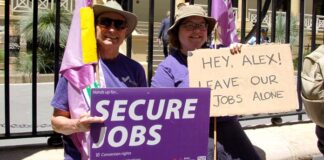The inspirational three-month long struggle by Hutchison wharfies in Sydney and Brisbane ended on 16 November, when Maritime Union (MUA) members voted to accept a new Enterprise Bargaining Agreement.
In early August, Hutchison sacked 97 of its 224 strong workforce with midnight text messages and emails. They used masked security guards to prevent sacked workers clearing out personal property from their lockers.
With the new agreement, around 60 workers have accepted voluntary “enhanced” redundancy that also allows them to be re-employed as casuals when work picks up. Limiting the job losses, and maintaining the closed shop, have been hard won victories against an aggressive employer in an era of neo-liberalism and an industry plagued by downsizing.
The result is a tribute to the willingness to take illegal strike action and a workforce prepared to stare down the threat of large fines. The determined presence of the MUA camp at Hutchison’s gates remained a rallying point throughout the dispute. There are also stories of industrial action at international ports that pressured Hutchison.
Anti-union laws
But opportunities were missed to defend every job and to challenge the government’s anti-trade union laws, used to push disputes into arbitration.
Management tried to excuse the sackings, saying there wasn’t enough work, even though Hutchison is the world’s largest stevedoring operator and was subcontracting ships to rival companies. Managers were also seen carrying documents entitled Phoenix Rising, rumored to be a plan for further mechanisation and redundancies.
In response, the entire Hutchison workforce, all MUA members, went on strike and defied Fair Work Australia orders to return to work. The strike was solid from the beginning with regular mass meetings and elected workplace committees. Hundreds of people and union delegations descended on Hutchison docks to show their solidarity. Labor leader Bill Shorten and ACTU president Ged Kearney visited the picket lines.
The sackings were similar to the 1998 lockout when Patrick stevedores dismissed its entire MUA workforce, in an operation organised by Chris Corrigan with the Howard government’s support. But unlike 1998, when Patrick trained non-union labour in Dubai, there was no scab workforce that could replace union members and operate a port. This put Hutchison workers and the MUA in a more powerful position to demand all the jobs back with no loss of conditions.
But concerns that the union could face fines by Fair Work or the Federal Court led union officials to emphasise reaching a deal with Hutchison.
The possibility of spreading the strike was dismissed, even though DP World was in a bargaining period and therefore had a right to take industrial action protected by law. The dispute could also have been used to begin a campaign against the anti-trade union laws that ban strikes and solidarity action and allow unions to be fined. Resolutions about the laws at mass meetings could have politicised the strike and begun to make repeal of these laws an industrial issue for the union movement.
There were mixed messages from the best of the union officials. At times, there were militant speeches, about not one job being lost. But these were also accompanied by warnings about fines and the possibility of Hutchison closing its gates for good if an agreement was not reached that allowed the multi-billion dollar company to remain “competitive”.
A week after the lockout, the Federal Court made an interim order that Hutchison re-hire the 97 sacked workers, but the MUA had to agree to initially cover the sacked workers’ pay until the dispute was resolved.
At first, it looked like a straight-out victory. Workers marched back into work chanting “Whose port? Our port!” But the court also said Hutchison did not have to engage the sacked workers.
It was a ruling designed to split the picket lines, and divide the workforce. They were back on the payroll but left outside the gate. Maximum unity means either everyone is in, or everyone has to be out. Accepting the ruling set the scene for the drawn out dispute.
With strike action ruled out, the union officials tried pressuring the company with a consumer boycott of Vodafone, a Hutchison subsidiary. But after a couple of small demonstrations this was dropped.
After three months on picket lines and considerable uncertainty about the future, it is not surprising that 60 workers took the enhanced redundancy offer. The new Enterprise Agreement also includes an increase from 30 to a 32 hour work week; still a shorter week than other companies. But introducing casualisation is a big win for the company, and was gleefully reported by the Financial Review.
Now, there will be battles on every shift in Sydney and Brisbane over the interpretation of the new EBA; over the number of casual shifts, future mechanisation plans and further redundancies. Their outcome will depend upon the strength and organisation of the workplace committees and union delegates, and a commitment to defend every job and condition backed up with the industrial action needed to win.
By Michael Douglas





